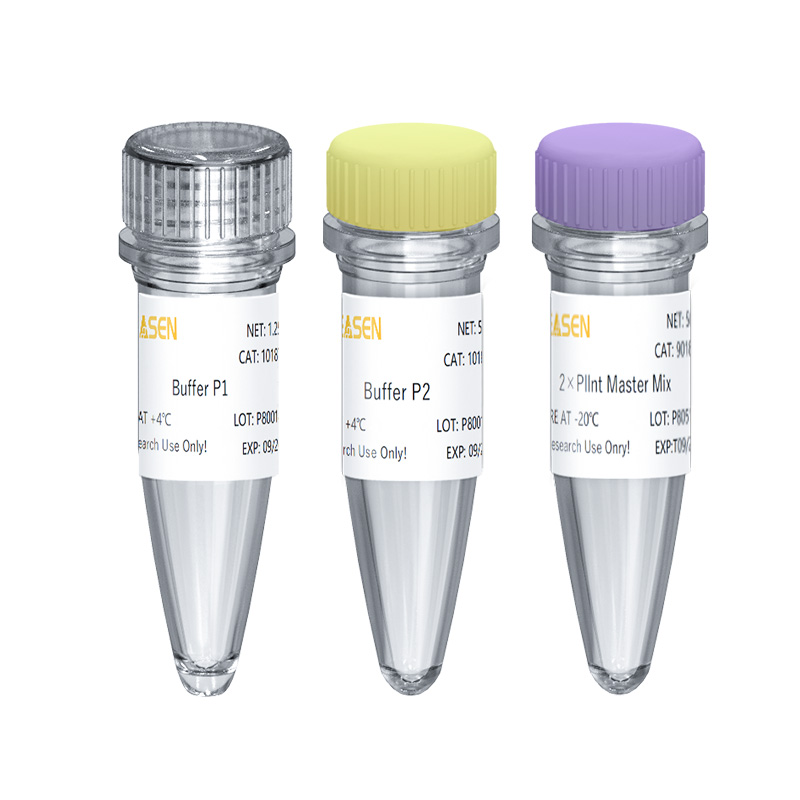Plant Tissue Direct PCR Kit (With Dye)
Product Description
Plant tissue direct PCR kit is a kit that can directly amplify different types of plant leaves by PCR, with wide adaptability and strong stability. The kit uses a unique lysis buffer system, which can quickly lyse a variety of plant samples and release genomic DNA. The released genomic DNA can be used directly as a template without removing protein, RNA, or secondary metabolites in PCR reaction. In addition, the kit requires a small amount of sample, as low as 1 mm plant leaves can be used for experiments.
The 2×Plant Master Mix provided in this kit has strong amplification compatibility and can directly use the lysate of the sample as a template for efficient and specific amplification. This reagent is a 2-fold concentrated PCR reaction mixture, which contains all the components used for PCR amplification except the template and primers, which greatly simplifies the operation process and reduces the chance of contamination.
The kit can be used for identification of transgenic plants, plant genotyping, etc.
Shipping
The products are shipped with ice packs.
Storage
1. Reagent 10187-A [Buffer P1] can be stored at 4℃ for 1 year.
2. Reagent 10187-B [Buffer P2], used for neutralizing lysate, which is beneficial to store the sample for a longer time, and can be stored at 4℃ for 1 year.
3. Reagent 10187-C [2× Plant Master Mix] can be stored at -20℃ for 1 year. Avoid repeated freezing and thawing.
Cautions
1. When doing leaf experiments, it is recommended to use freshly collected leaf tissue. If it is a long-term frozen tissue, it needs to be stored at -80°C. Repeated freezing and thawing should be avoided as much as possible to avoid template degradation and affect PCR efficiency. The leaf tissue is suitable for young leaves. If it is a mature leaf, avoid using the tissue of the main vein of the leaf.
2. It is recommended to amplify the fragment within 1 kb in length for the best amplification efficiency.
3. When sampling, use a hole punch or knife to take a sample of suitable size. When the samples are different, the hole punch or knife needs to be cleaned every time before processing the sample.
4. For leaf tissue, it is recommended to take 1-10 mm leaves, too small leaf length will lead to low PCR amplification yield, too much will inhibit the PCR reaction, use the method of thermal cracking, mashing with a pipette tip, and crushing with a grinder to treat plant leaves. After treatment, it needs to be shaken and centrifuged. Be sure to take the supernatant for testing. Precipitation will seriously inhibit the PCR reaction.
5. For your safety and health, please wear lab coats and disposable gloves for operation.
6. This product is for research use ONLY!
|
Common Problems |
Possible causes |
Solutions |
|
There were no bands in the positive control and the samples to be tested. |
The PCR reaction system or reaction conditions were not suitable. |
Use gradient PCR to explore the optimal reaction conditions for PCR. |
|
Improper storage of PCR reagents inactivates them. |
2×PCR Mix should be stored at -20℃, avoid repeated freezing and thawing when using. If used frequently, it can be stored at 4°C for a short time. |
|
|
Primer design issues. |
Try redesigning the primers to check. |
|
|
The positive control has a band of interest, and the sample to be tested has no band or a weak band. |
The ratio of lysis buffer and neutralization buffer is inappropriate, and the lysis mixture will affect the pH value of the PCR system. |
Under normal conditions, the pH of the neutralized lysis mixture should be around 7-8 (the lysis product and Buffer P2 should be neutralized in strict accordance with the ratio of 5:1). |
|
The sample lysis mixture has been stored improperly or for too long, and the DNA genome has been degraded. |
The lysate mix can be stored at 4°C for 5 days, try to use a freshly prepared lysate mix for PCR. |
|
|
The amount of template added is not suitable. |
Optimize the amount of template added within the range of <5% of the reaction system. |
|
|
Insufficient number of PCR cycles. |
Appropriately increase the number of PCR cycles, preferably 35-40 cycles. Due to the complexity of the template, it is generally better to use 5-10 more cycles of PCR reaction than using purified DNA template. |
|
|
Nonspecific amplification |
PCR annealing temperature too low, cycle number, primer concentration, or template concentration too high. |
Increase PCR annealing temperature and decrease PCR cycle number, primer concentration, or template concentration. |
|
PCR primer mismatch. |
Redesign PCR primers. |
|
|
The temperature is too high when preparing the PCR reaction system or the placed time is too long after the preparation. |
The preparation of the PCR reaction system is carried out at low temperature, and the PCR amplification reaction is carried out as soon as possible after the preparation is completed. |
|
|
Target band appears in negative control |
Contamination of operating tools or reagents. |
All reagents or equipment in the experiment should be autoclaved. Be careful and gentle when handling to prevent the target sequence from being sucked into the sample gun or spilled out of the centrifuge tube. |
|
Cross-contamination between samples. |
Each sampler is only used for one sample; or after taking one sample, immerse the sampler blade in 2% sodium hypochlorite solution, rinse repeatedly, and then dry the residue with a clean paper towel. |
Catalog No.:*
Name*
phone Number:*
Lot:*
Email*
Country:*
Company/Institute:*
Related articles

